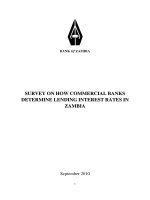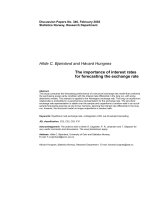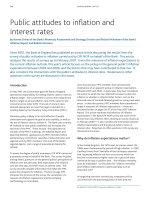understanding interest rates
Bạn đang xem bản rút gọn của tài liệu. Xem và tải ngay bản đầy đủ của tài liệu tại đây (164.83 KB, 23 trang )
Copyright 2011
Pearson Canada Inc.
4 -
1
Chapter 4
Understanding Interest Rates
Copyright 2011
Pearson Canada Inc.
4 -
2
Present Value
•
A dollar paid to you one year from now
is less valuable than a dollar paid to
you today.
Copyright 2011
Pearson Canada Inc.
4 -
3
Discounting the Future
Let i = 0.10
In one year $100 x (1+0.10)= $110
In two years $110 x (1+0.10)=$121
or $100 x (1+0.10)
2
In three years $121 x (1+0.10)= $133
or $100 x (1+0.10)
3
In general $100 dollars in n years:
$100 x (1+i)
n
Copyright 2011
Pearson Canada Inc.
4 -
4
Simple Present Value
PV = today’s present value
CF = future cash flow or
payments
i = interest rate
n
i
CF
PV
)1( +
=
Copyright 2011
Pearson Canada Inc.
4 -
5
Four Types of Credit Market Instruments I
1. Simple Loan: The lender provides the borrower
with the principal that is repaid at the maturity
date with interest
2. Fixed Payment Loan: The lender provides the
principal which is repaid by making the same
payment (principal + interest) every period for
a set period of time.
Copyright 2011
Pearson Canada Inc.
4 -
6
Four Types of Credit Market Instruments II
3. Coupon Bond: A coupon bond pays the owner of the
bond a fixed interest payment (coupon payment)
every year until the maturity date, when a specified
final amount (face value or par value) is repaid
4. Discount Bond: A discount bond (also called a zero-
coupon bond) is bought at a price below its face
value (at a discount), and the face value is repaid at
the maturity date.
- special case: consol bond (perpetuity)
Copyright 2011
Pearson Canada Inc.
4 -
7
Yield to Maturity
•
The yield to maturity is the interest rate that
equates the present value of cash flow
payments received from a debt instrument with
its value today.
Copyright 2011
Pearson Canada Inc.
4 -
8
Simple Loan—Yield to Maturity
PV = amount borrowed = $100
CF = cash flow in one year = $110
n= number of years = 1
100$
110$
)1(
110$100$)1(
)1(
110$
100$
1
1
=+
=+
+
=
i
xi
i
For simple loans, the simple interest rate equals the
yield to maturity
Copyright 2011
Pearson Canada Inc.
4 -
9
Fixed Payment Loan – Yield to Maturity
The same cash flow payment every period throughout the
life of the loan
LV= loan value
FP = fixed yearly payment
n= number of years until maturity
n
i
FP
i
FP
i
FP
LV
)1(
)1(1
2
+
++
+
+
+
=
Copyright 2011
Pearson Canada Inc.
4 -
10
Coupon Bond—Yield to Maturity I
Using the same strategy used for the fixed-payment
loan
P=price of coupon bond
C = yearly coupon payment
F= face value of the bond
n= years to maturity
nn
i
F
i
C
i
C
i
C
i
C
P
)1()1(
)1()1(1
32
+
+
+
++
+
+
+
+
+
=
Copyright 2011
Pearson Canada Inc.
4 -
11
Coupon Bond—Yield to Maturity II
Copyright 2011
Pearson Canada Inc.
4 -
12
Three facts about coupon bonds:
1. When the coupon bond is priced at its face value,
the yield to maturity equals the coupon rate.
2. The price of a coupon bond and the yield to
maturity are negatively related.
3. The yield to maturity is greater than the coupon
rate when the bond price is below its face value.
Coupon Bond—Yield to Maturity III
Copyright 2011
Pearson Canada Inc.
4 -
13
Consol or Perpetuity
•
A bond with no maturity date that does not repay
principal but pays fixed coupon payments forever.
c
c
c
c
P
C
P
i
C
P
=
=
=
=
=
c
c
i :as equation above the rewrite Can
consol theof maturity to yield i
payment interest yearly C
consol theof price
For coupon bonds, current yield is an approximation
of yield to maturity
Copyright 2011
Pearson Canada Inc.
4 -
14
Discount Bond—Yield to Maturity
For any one year discount bond:
P
PF
i
−
=
F = face value of the discount bond
P =current price of the discount bond.
The yield to maturity equals the increase in price
over the year divided by the initial price. As with
a coupon bond, the yield to maturity is negatively
related to the current bond price
Copyright 2011
Pearson Canada Inc.
4 -
15
Yield on a Discount Basis
Yield on a discount basis:
maturity to days
365
x
P
PF
i
db
−
=
i
db
= yield on a discount basis
F= face value
P= purchase price
Copyright 2011
Pearson Canada Inc.
4 -
16
Rate of Return
g gain capitalof rate
i yield current
P
C
payment coupon C
1t time at bond theof priceP
t time at bondof price P
1t to t time from bond the holding from return
1
c
t
1t
t
1
==
−
==
=
+=
=
+=
−
+=
+
+
+
t
tt
t
tt
t
P
PP
RET
P
PP
P
C
RET
Copyright 2011
Pearson Canada Inc.
4 -
17
Rate of Return and Interest Rates I
•
The return equals the yield to maturity only if the
holding period equals the time to maturity.
•
A rise in interest rates is associated with a fall in
bond prices, resulting in a capital loss if time to
maturity is longer than the holding period.
•
The more distant a bond’s maturity, the greater the
size of the percentage price change associated with
an interest-rate change.
Copyright 2011
Pearson Canada Inc.
4 -
18
Rate of Return and Interest Rates II
•
The more distant a bond’s maturity, the lower the
rate of return that occurs as a result of an increase in
the interest rate.
•
Even if a bond has a substantial initial
interest rate, its return can be negative if interest
rates rise.
Copyright 2011
Pearson Canada Inc.
4 -
19
Rate of Return and Interest Rates III
Copyright 2011
Pearson Canada Inc.
4 -
20
Interest-Rate Risk
•
Prices and returns for long-term
bonds are more volatile than those for
shorter-term bonds.
•
There is no interest-rate risk for any bond
whose time to maturity matches the holding
period.
Copyright 2011
Pearson Canada Inc.
4 -
21
Real and Nominal Interest Rates
•
Nominal interest rate makes no allowance
for inflation.
•
Real interest rate is adjusted for changes in price
level so it more accurately reflects the cost of
borrowing.
•
Ex ante real interest rate is adjusted for expected
changes in the price level.
•
Ex post real interest rate is adjusted for actual
changes in the price level.
Copyright 2011
Pearson Canada Inc.
4 -
22
Fisher Equation
e
r
ii
π
+=
i = nominal interest rate
i
r
= real interest rate
π
e
= expected inflation rate
When the real interest rate is low, there are greater
incentives to borrow.
Low interest rates reduces the incentives to lend.
The real interest rate is a better indicator of the
incentives to borrow or lend.
Copyright 2011
Pearson Canada Inc.
4 -
23
Indexed Bonds
•
December 10, 1991, when the government of
Canada began to issue indexed bonds.
•
Indexed bonds are bonds whose interest and
principal payments are adjusted for changes in
the price level









